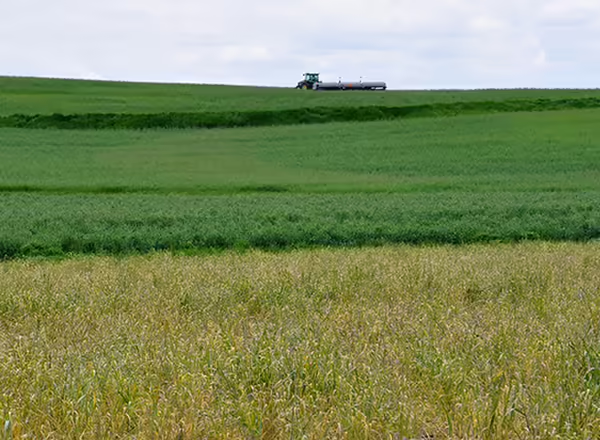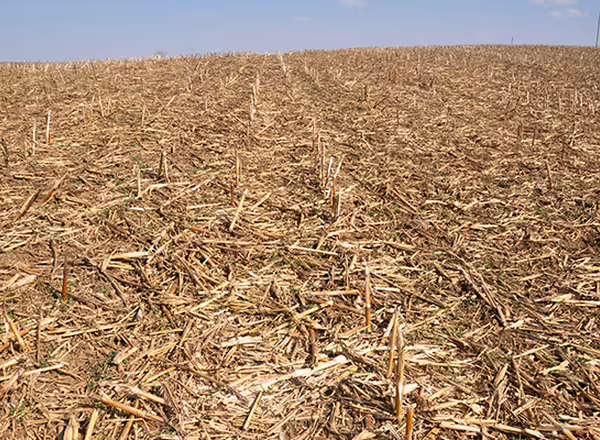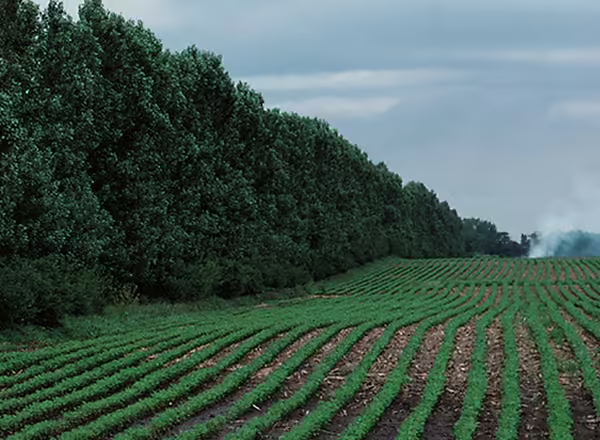
This blog post continues a series analyzing the local dust storms that have occurred across the area recently. Part one looked at the specific causes of wind erosion and dust storms and their impacts on agriculture. This second part examines practices that producers can implement on their operations to reduce the effects of wind erosion.
Understanding how soil erosion works and the factors that impact it is crucial in reducing its impact on agricultural systems. While producers cannot control or prevent high winds, there are best management practices that can reduce wind erosion and keep valuable topsoil in the field. These practices include cover crops, tillage and residue management, and windbreaks.

Effective cover crop management is widely viewed as one of the most essential best management practices for reducing wind erosion. Several factors impact a cover crop’s performance and ability to reduce the effects of wind erosion. Part of the idea with cover crops is that they cover and protect the soil from different types of erosion. This protection for the soil comes from biomass. If enough biomass is produced from a cover crop, then cover crops can effectively manage wind erosion. This is particularly true during critical periods when the risk of wind erosion is high and in areas where the soil is more susceptible to wind erosion. The type of cover crop used can also influence its ability to protect the soil. While some may think that all cover crops can reduce wind erosion, certain characteristics are important to consider when choosing the right variety. These characteristics are high biomass production, winter hardiness, resistance to drought, and rapid growth. Suppose a producer is looking to decide what type of cover crop should be used to reduce wind erosion. In that case, grass-like cover crops (i.e., triticale, winter rye, or sorghum-sudangrass) are more effective at reducing wind erosion than legume cover crops (i.e., red or white clover). Even among grass cover crops, certain species are more effective. For example, sorghum-sudangrass was found to be more effective than millet since it produced almost twice as much biomass, had better surface coverage, and resulted in larger soil particles. Another factor to consider with cover crops is their growth stage and seeding rate. As a cover crop matures in the field, it becomes more effective at reducing wind erosion, with cover crops that are near full maturity being the most effective. Higher seeding rates are also crucial to reducing wind erosion. The main benefit of higher seeding rates is higher biomass production. If, for example, a cover crop is seeded in at a low rate, the smaller amount of residue will decompose faster and thus leave the soil more exposed. Increasing the seeding rate will produce more biomass and crop residue to protect the soil from wind erosion.

Tillage is an essential step in crop production, as it prepares a field for planting. Producers have used tillage for thousands of years to prepare a seedbed, as planting seeds requires some form of tillage practice. However, tillage can significantly impact soil quality and its ability to resist wind erosion. When tillage practices loosen soil, it becomes more susceptible to either wind and/or water erosion. While tillage can be used to inject fertilizers into the soil and control insects or other pests, the long-term impacts on soil quality and productivity could potentially offset any efforts to improve the soil. Many producers have looked to no-till or minimum-tillage practices as a solution to the issue of soil erosion caused by conventional tillage. No-till is rooted in conservation agriculture (CA) and is characterized by minimum soil disturbance, continuous crop residue cover, and using cover crops or diverse crop rotations to protect soil from erosion. Weed control is often discussed as a major issue with no-till systems, as the soil is not disturbed in such a way that prevents weed growth. However, no-till does not mean a producer can never till their field. If herbicides or other chemical products cannot be used, a producer can use tillage to control weeds, especially in a field where weed growth is out of control. The answer to reducing the risk of soil erosion is not solely in no-till. Indeed, no-till is not a magic key to preventing soil erosion from wind. Instead, it is one practice that can be utilized in an operation as part of a site-specific management plan for each field.

Windbreaks and hedgerows used to be commonplace across the United States. However, policies that encouraged farming “fencerow to fencerow” caused many landowners to remove windbreaks in favor of crop production. A windrow is a row of trees, shrubs, and other vegetation planted along the edges of a field to decrease wind speeds across a field, particularly in flat or sandy fields. While there are limitations on how long a windbreak can be, it has been shown that a windbreak will decrease the wind speed at ten to 15 times its height. This saves the topsoil from high winds and can also protect crops that may be susceptible to wind damage. With the most damaging winds coming from the North and West, orienting a windbreak perpendicular to the direction of high winds is recommended. There are many resources for designing a windbreak, including its width, species, varieties of trees and shrubs, and ideal planting conditions.
Wind erosion is a severe concern for producers across the United States and Central Illinois. High winds can carry soil particles away from the field, decreasing available topsoil and overall soil productivity. While producers cannot prevent or completely stop high winds, they can implement practices to reduce the risk of wind erosion and dust storms. Planting cover crops, adjusting tillage practices, and establishing windbreaks can all be useful management practices to protect their fields from the damaging effects of wind erosion. Programs and resources are available to help farmers implement these practices on their operations through various governmental organizations (i.e., the USDA NRCS and Soil and Water Conservation Districts) and other entities (i.e., University of Illinois Extension). By considering these practices, producers in Central Illinois can protect their soil, enhance soil productivity, and keep others safe when there are high winds.
Reagen Tibbs serves as the commercial agriculture educator for Logan, Menard, and Sangamon counties. He provides educational opportunities and serves as a resource for agricultural producers in Central Illinois.